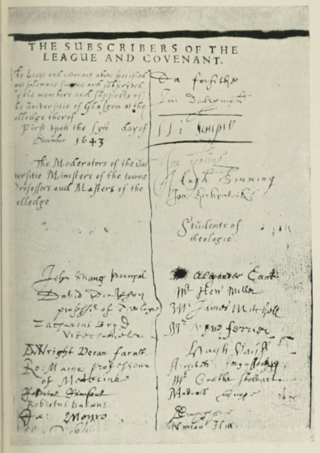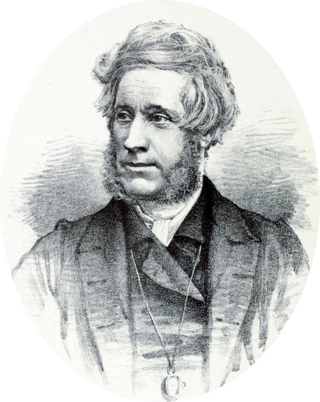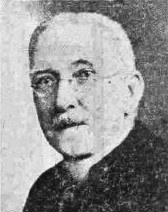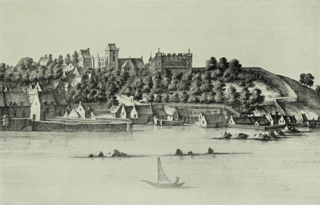Related Research Articles

Robert Wodrow was a Scottish minister and historian, known as a chronicler and defender of the Covenanters. Robert Wodrow was born at Glasgow, where his father, James Wodrow, was a professor of divinity. Robert was educated at the university and was librarian from 1697 to 1701. From 1703 till his death, he was parish minister at Eastwood, near Glasgow. He had sixteen children, his son Patrick being the "auld Wodrow" of Burns's poem Twa Herds.

David Welsh FRSE was a Scottish Presbyterian minister and academic. He was Moderator of the General Assembly of the Church of Scotland in 1842. In the Disruption of 1843 he was one of the leading figures in the establishment of the Free Church of Scotland.

David Dickson (1583–1663) was a Church of Scotland minister and theologian.

John Strang (1584–1654) was a Scottish minister and Principal of Glasgow University. He was a signator to the National Covenant of 1638.
Robert Liston was a Scottish minister who served as Moderator of the General Assembly of the Church of Scotland in 1787/88.
Neil Campbell was a Scottish minister, moderator of the General Assembly of the Church of Scotland at the start of the Original Secession and Principal of Glasgow University during a flourishing period of the Scottish Enlightenment.
William Leechman or Leishman (1706–1785) was a Scottish minister, theologian and academic. He was Professor of Divinity and later Principal at Glasgow University.
William Purdie Dickson DD LLD (1823–1901) was a Scottish minister and theologian. He was Professor of Divinity at the University of Glasgow from 1873 to 1895. The William Dickson Prize is named in his honour.

James Hog was a Scottish Presbyterian minister at Carnock, known for his role in the Marrow Controversy within the Church of Scotland.
The disastrous General Assembly of Aberdeen was held in 1605. A few ministers of the Presbyterian party met in defiance of royal authority as the general assembly was prohibited by royal proclamation. There was doubt about the legality of the sederunt and the cancelling or the prorogation of the assembly; several of the ministers denied that the king had the authority in what they regarded as a purely spiritual matter. The king disagreed and several who met were tried at Linlithgow for high treason and exiled. They were: John Forbes of Alford; John Welch of Ayr, ; Andrew Duncan; Robert Dury, Anstruther; Alexander Strachan, Creich; and John Sharp, Kilmany. After the assembly King James gave more power to his bishops.

William King Tweedie (1803–1863) was an historian, biographer and a minister of the Free Church of Scotland Tolbooth Church, Edinburgh.

James Montgomery Campbell (1859-1937) was a Scottish clergyman who served as Moderator of the General Assembly of the Church of Scotland in 1928.

Michael Potter was a covenanter. He graduated from Edinburgh on 27 July 1663. He was licensed to preach the gospel in 1673. He was a tutor to the family of George, the Laird of Dunglass of that ilk. He was ordained by presbytery for the adherents in the parish of St. Ninians in 1673. He was elected a schoolmaster to Culross by the magistrates. This led to them being summoned before the Privy Council in 1677.
William Wilson was born in Glasgow, on 9 November 1690. He was the son of Gilbert Wilson, proprietor of a small estate near East Kilbride.. William Wilson's mother was Isabella, daughter of Ramsay of Shielhill. William was named after William of Orange and was educated at University of Glasgow, graduating with an M.A. in 1707. He was licensed by the Presbytery of Dunfermline on 23 September 1713 and called unanimously on 21 August 1716. He was ordained on 1 November 1716. He had a call to Rhynd, but was continued by the Presbytery in Perth. Associating with the supporters of the Marrow of Modern Divinity, he with three others Ebenezer Erskine, Alexander Moncrieff, and James Fisher laid the foundation of the Secession Church, for which they were suspended by the Commission of Assembly 9 August, and declared no longer ministers of the Church 12 November 1733. He was deposed by the Assembly 15 May 1740. He and his people erected a meeting-house, and the Associate Presbytery appointed him their Professor of Divinity, 5 November 1736, but he sank under his contentions and labours and died 8 October 1741. He is said to have combined "the excellencies of both Erskines, with excellencies peculiar to himself."
Patrick Simson (1566-1618) was a presbyterian minster who served in Stirling during the reign of James VI of Scotland. Despite his opposition to Episcopalianism, he had the respect of king James and several of his court. He was born in Perth in 1556. He was from a prominent church family and was the son of Andrew Simson, minister of Dunbar. He was educated at St. Mary's College, St Andrews, graduating with an M.A. in 1574. He became a reader at Borthwick and completed his education at Bridgestock in England stopping there while intended for Cambridge as he met a gentleman who allowed him use of his library. He was admitted to Spott in 1577 and translated to Cramond in 1582. He was admitted to the vicarage there on 30 August 1586. He was translated and admitted to Stirling on 7 August 1590. He was presented by James VI on May 1591. When preaching before the King in 1598 he exhorted him to beware "lest he drew on himself secret wrath by setting up manifest idolatry." Immediately after the sermon his Majesty arose and "forbade him to meddle in these matters." He was a member of twelve out of fifteen Assemblies held prior to 1610. Simson was proposed by Assembly of 1606 "Constant Moderator" of Presbytery, but he lost to James Nicolson. He drew up a Protest to Parliament against the introduction of Episcopacy on 1 July 1606. He was chosen as Moderator of Conference at Falkland on 15 June 1608. Simson was offered a bishopric and pension by the King, but frequent attacks of disease broke down his constitution, and he died on 31 March 1618.
Archibald Simpson, born in 1564, was a Christian minister, author and poet in Scotland.
Patrick Simson or Sympson (1628–1715) was a Church of Scotland minister who served as Moderator of the General Assembly in 1695. He was Dean of the Faculty of Divinity at Glasgow University. At the time of his death in 1715 he was the acknowledged Father of the Church.
Thomas Taylor (c.1770–1831) was a 19th century Church of Scotland minister, who served as Moderator of the General Assembly in 1826.

Robert Trail DD (1720–1775) was an 18th century Scottish minister who served as Professor of both Oriental Languages and Divinity at Glasgow University and as Moderator of the General Assembly of the Church of Scotland in 1762.
John Stirling (1654–1727) was a minister of the Church of Scotland in the 17th/18th centuries who served as Principal of Glasgow University from 1701 to 1727 and in 1707 attained the highest post in the Scottish church as Moderator of the General Assembly.
References
Citations
Sources
- Gordon, Alexander (1897). "Simson, John". In Lee, Sidney (ed.). Dictionary of National Biography . Vol. 52. London: Smith, Elder & Co.
 This article incorporates text from this source, which is in the public domain .
This article incorporates text from this source, which is in the public domain . - Reid, Henry Martin Beckwith (1923). The divinity professors in the University of Glasgow, 1640-1903. Glasgow: Maclehose, Jackson and Co. pp. 204–240.
 This article incorporates text from this source, which is in the public domain .
This article incorporates text from this source, which is in the public domain . - Scott, Hew (1917). Fasti ecclesiae scoticanae; the succession of ministers in the Church of Scotland from the reformation. Vol. 2. Edinburgh: Oliver and Boyd. p. 302.
 This article incorporates text from this source, which is in the public domain .
This article incorporates text from this source, which is in the public domain . - Scott, Hew (1928). Fasti ecclesiae scoticanae; the succession of ministers in the Church of Scotland from the reformation. Vol. 7. Edinburgh: Oliver and Boyd. p. 400.
 This article incorporates text from this source, which is in the public domain .
This article incorporates text from this source, which is in the public domain .